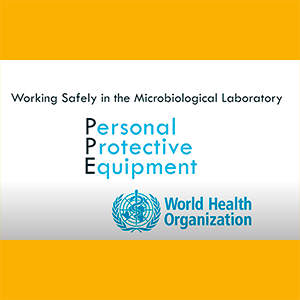Personal Protective Equipment
Personal protective equipment (PPE), such as gloves, respiratory protective masks, lab coats, footwear, etc. form the first line of defence when handling hazardous biological materials.
PPE should be selected based primarily on the hazards identified during the risk assessment. However, the fit and comfort of PPE should be considered when selecting the most appropriate one. PPE that fits well and is comfortable to wear will promote its use. Most protective items are available in various sizes and care should be taken to select the most appropriate for each individual case.
PPE
- It can never be a substitute for good working practice or collective protection equipment.
- Misuse of PPE creates further risk because it can induce a false sense of security.
- Choice of equipment is based on the maximum level of risk that is anticipated.
- It must be the right size for each user.
- It requires suitable cleaning and maintenance.
- It can only be used if it carries the CE mark.
Who is responsible for enforcing the correct use of PPE?
The PI or Supervisor is responsible for ensuring that their staff use, maintain, replace and dispose of PPE correctly.
Can I wear shorts/ open shoes if I am going to be sitting at my lab table all day?
No. Shorts or open shoes should never be worn in the laboratory where hazardous materials are used.
Should people visiting a laboratory wear PPE?
If visitors are not directly involved in a laboratory operation, but there is a risk of potential exposure to hazardous materials and/or physical hazards, they should wear at least a lab coat, safety glasses, and appropriate street clothing.
What are the requirements to wear PPE outside the laboratory?
Gloves and lab coats cannot be worn in common areas, such as cafeterias, dining rooms, conference rooms, offices and libraries. For laboratories that use human pathogens or work in aseptic conditions, laboratory coats may not be worn outside the laboratory. In other types of laboratories, a lab coat may be worn when walking down a hallway between laboratories or support rooms, such as a cold chamber or an freezer room.
Is the lab coat considered PPE?
If the lab coat does not specifically protect against any risk and is used solely to preserve personal clothing, it is not considered PPE and therefore does not carry CE marking.
I only work with non-hazardous solutions. Why do I need to wear safety glasses and a lab coat?
It is not strictly necessary but it is important that there is a common standard for all laboratories to create a culture of safety through widespread modeling of safe behaviors.
Do I have to wear safety glasses while working at my desk, which is in a laboratory where hazardous materials are used?
Not if it is separated physically from the work table and contamination is unlikely.
Do I have to wear safety glasses when working on the microscope?
Safety glasses can be temporarily removed while viewing materials on the microscope.
Why is it sometimes necessary to use double gloves?
Gloves are prone to tears and punctures during use and, therefore, in higher risk conditions, the use of two pairs of gloves, as opposed to one pair, is considered to provide an additional barrier, further reducing the risk of cross contamination.
Is it possible to share PPE between different people?
PPE is, in principle, for personal and individual use. However, RD 773/1997 establishes in article 7.3:
"If circumstances require the use of equipment by several people, the necessary measures will be adopted so that this does not cause any health or hygiene problems for the different users."
It is generally understood that these circumstances may occur in certain situations where the use of PPE is limited to short periods of time or is infrequent. It must always be ensured that the degree of adaptation to each of the potential users is such that it allows them all to be protected in the same way or, at least, above the acceptable level of protection predetermined in the risk assessment.

